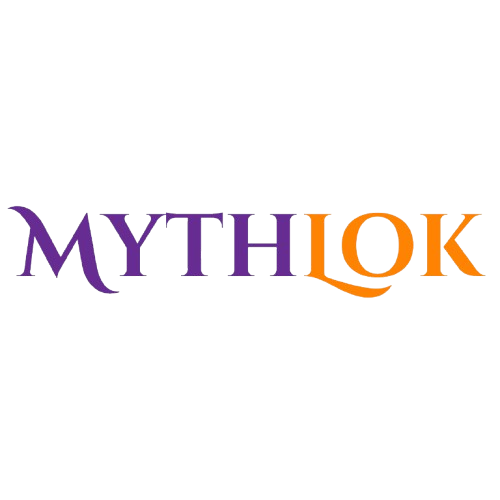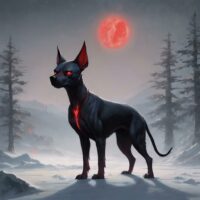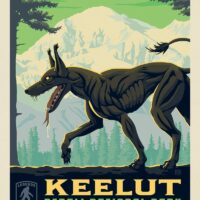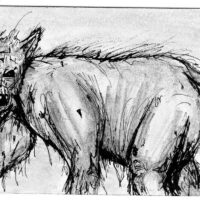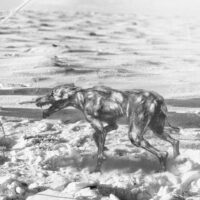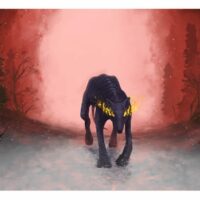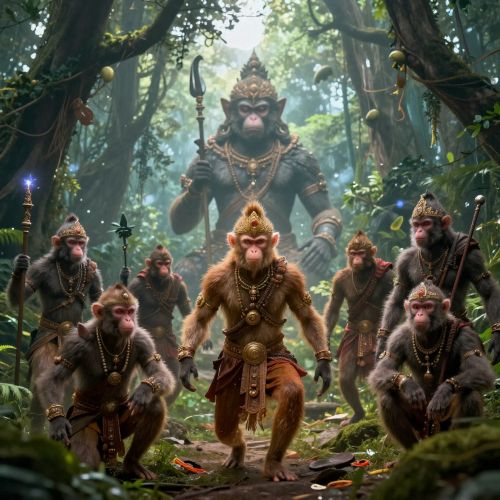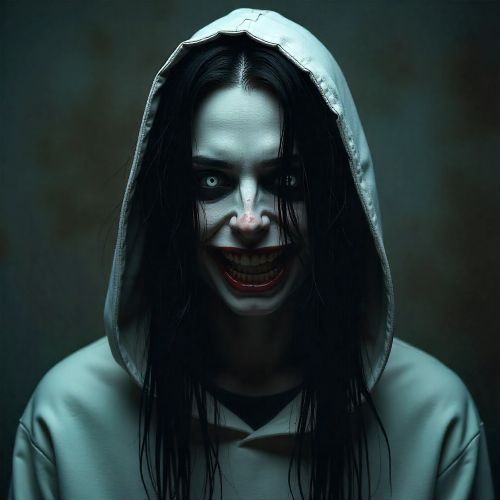Keelut : The Haunting Dog
Listen
At a glance
| Description | |
|---|---|
| Origin | Inuit Mythology |
| Classification | Animals |
| Family Members | N/A |
| Region | Alaska |
| Associated With | Supernatural Abilities, Hunting |
Keelut
Introduction
The Keelut, a spectral being from Inuit mythology, is renowned for its supernatural abilities and association with death, haunting remote regions like Denali National Park. Its legend, steeped in tales of the supernatural and death, remains vivid in contemporary culture, inspiring various artistic interpretations. Among the Inuit, who have inhabited the Arctic for millennia, the Keelut occupies a unique place in their folklore. Described as a hairless, featureless dog-like entity, it embodies the dangers and mysteries of the frozen north. Exploring the Keelut’s physical traits, familial ties, alternate names, and perceived powers sheds light on its enduring impact across generations. This chilling spirit serves as a cautionary tale, reminding the Inuit of the profound connection between nature and the unseen world.
Physical Traits
The Keelut is a large, hairless dog-like creature with a sleek, ominous appearance and eerie demeanor. Its eyes are said to glow with an otherworldly light, instilling fear in those who encounter it. Some tales depict the Keelut as having sharp teeth and a powerful, muscular build, enhancing its formidable presence. Unlike ordinary dogs, the Keelut is entirely black, hairless, and lacks discernible facial features or eyes. Its glistening, oily skin is cold to the touch, adding to its unsettling nature. This creature is noted for its stealth and ability to blend into darkness, making it a formidable figure in Inuit folklore.
The most striking feature of the Keelut is its monstrous, hairless form that blends seamlessly with the long Arctic nights. Its body is devoid of fur except for tufts on its paws, ears, and tail tip, allowing it to move silently across the snow without leaving tracks. The Keelut’s eyes, glowing an eerie red or white, pierce through the darkness and strike fear into the hearts of those who encounter it. Some legends even describe the Keelut with multiple pairs of legs, enhancing its nightmarish appearance and hinting at its supernatural nature.
Family
The Keelut is a solitary entity in Inuit mythology, not typically associated with a specific pack or hierarchy like many other mythological creatures. It is described as a malevolent spirit that roams the frozen wastelands, drawn to the aura of fear and despair. While some suggest the Keelut might be connected to the pantheon of Inuit spirits, possibly a creature of the underworld that breaches the veil between worlds during harsh winter months, its exact origins and purpose remain shrouded in mystery.
In the rich tapestry of Inuit mythology, the Keelut’s origins can be traced back to ancient folklore, where it emerged as a creature with otherworldly connections. While it is not explicitly linked to a particular family or lineage within the Inuit pantheon, it shares a supernatural origin rooted in folklore and belief systems with other mythical creatures.
The Keelut is often associated with other supernatural beings in Inuit mythology, particularly as a companion or harbinger of death. Legends suggest it is the counterpart or guardian of another mythical creature known as the Amarok, a giant wolf-like creature that hunts alone in the Arctic night. This relationship underscores the Keelut’s role as a sentinel or forewarning of impending danger. Despite its solitary nature, the Keelut is sometimes linked with spirits or entities from the spirit world, amplifying its supernatural aura within Inuit narratives.
Other names
The Keelut is recognized by various names across different Inuit communities. In some regions, it is referred to as the “Qiqirn,” emphasizing its spectral qualities and association with death. Similarly, the term “Tariaksuq” is used to describe similar entities in Inuit mythology, reflecting diverse interpretations of this shadowy figure throughout Arctic cultures. These alternate names underscore the widespread recognition and deep-rooted fear associated with encountering such a creature in the frozen wilderness.
In different parts of Inuit territory, the Keelut is also known by other names. Some communities speak of the “Arqilliq” or the “Tunnera erneq,” highlighting the diversity of Inuit cultures and the universal fear inspired by this spectral beast. These variations in names across the vast expanse of Inuit lands illustrate the enduring impact and significance of the Keelut in Arctic folklore.
Powers and Abilities
The Keelut, a creature of Inuit mythology, is feared not for its physical form but for its potent supernatural abilities. Its mere presence can induce madness in humans and animals alike, causing violent outbursts or paralyzing terror. Legends suggest that its gaze has the power to steal one’s soul, leaving behind a lifeless husk. This malevolent spirit is believed to be most active during the harsh Arctic winters, when the isolation and scarcity of resources can push individuals to their limits. In this desolate landscape, the Keelut’s powers are said to be amplified, instilling profound fear among those who dare to venture into its domain.
Despite its fearsome reputation, the Keelut is said to have vulnerabilities. It is believed to be startled by loud noises and avoids hearing its own name spoken aloud. Additionally, the Angakkuq, or Inuit shamans, were said to possess rituals and amulets that offered protection against the Keelut’s malevolent influence. These protective measures hint at the deep-rooted fear and respect the Inuit held for this spectral creature, which embodied the dangers lurking in the frozen wilderness.
In Inuit folklore, the Keelut is described as possessing unique powers that set it apart from ordinary animals. Despite lacking eyes, it has a keen sense of perception, able to detect danger from great distances. Its stealth and agility make it an elusive figure, seldom seen but often felt through primal instincts in the Arctic tundra. The Keelut’s presence is believed to herald misfortune or serve as an ominous warning, adding layers of superstition and caution to its mythological persona that continues to captivate imaginations to this day.
Modern Day Influence
The impact of the Keelut on modern mythology is significant, as it continues to captivate and inspire creators across various artistic mediums. Its presence in contemporary culture bridges the gap between ancient legends and present-day storytelling, with writers and filmmakers reimagining its essence in captivating narratives that explore its supernatural abilities and dark allure. Beyond traditional storytelling, the Keelut’s image has found a place in contemporary art, celebrating its cultural significance and evoking a sense of mystery and reverence. While the world inhabited by the Inuit has evolved, the legend of the Keelut persists as a reminder of nature’s power and the unseen forces that shape our lives, encouraging respect for the delicate balance of the Arctic ecosystem and the importance of community in adversity.
In addition to literature and film, the Keelut has become a subject of contemporary Inuit art, music, and storytelling. Sculptures and paintings depict its menacing form, while oral traditions continue to pass down stories, serving as cautionary tales and preserving the rich cultural heritage of the Inuit people.
In contemporary times, the legend of the Keelut resonates within Inuit culture and beyond, symbolizing ancestral wisdom and the unseen forces that shape human existence. This creature serves as a poignant reminder of the profound connection between indigenous communities and their mythological heritage, preserving stories that transcend time and geography while celebrating the enduring spirit of those who call the Arctic home.
Related Images
Frequently Asked Questions
What is lorem Ipsum?
I am text block. Click edit button to change this text. Lorem ipsum dolor sit amet, consectetur adipiscing elit. Ut elit tellus, luctus nec ullamcorper mattis, pulvinar dapibus leo.
What is lorem Ipsum?
I am text block. Click edit button to change this text. Lorem ipsum dolor sit amet, consectetur adipiscing elit. Ut elit tellus, luctus nec ullamcorper mattis, pulvinar dapibus leo.
What is lorem Ipsum?
I am text block. Click edit button to change this text. Lorem ipsum dolor sit amet, consectetur adipiscing elit. Ut elit tellus, luctus nec ullamcorper mattis, pulvinar dapibus leo.
What is lorem Ipsum?
I am text block. Click edit button to change this text. Lorem ipsum dolor sit amet, consectetur adipiscing elit. Ut elit tellus, luctus nec ullamcorper mattis, pulvinar dapibus leo.
What is lorem Ipsum?
I am text block. Click edit button to change this text. Lorem ipsum dolor sit amet, consectetur adipiscing elit. Ut elit tellus, luctus nec ullamcorper mattis, pulvinar dapibus leo.

